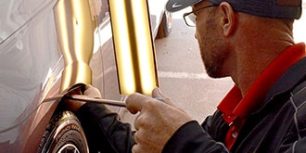Annual car maintenance is often neglected. Sure, your car runs great now, but when did you last inspect your belts and hoses? When was your last transmission flush? How’s your battery?
Don’t wait until there’s an issue. There are plenty of preventative car maintenance checks you can resolve to do right now to keep your vehicle on the road and out of the shop. Maintain your car year after year with Dent Wizard’s annual vehicle maintenance checklist.
1. Routine Oil Checks and Changes
Checking your oil level is one of the easiest preventative car maintenance measures, maybe even easier than filling your gas tank! Checking your oil level is especially critical if you have an older vehicle that regularly burns through oil. For older vehicles, checking your oil levels every time you fill up your gas is advised. For newer vehicles, you’re probably safe taking this preventative car maintenance measure once a month.
Follow your owner’s manual for instructions on how often you should be changing your oil. The standard “every 3,000 miles” doesn’t apply to as many newer vehicles, so double-check before you schedule an oil change. However, don’t push off your oil change until the last minute; this could lead to severe and costly engine issues down the road.
If you are burning through oil to the point where you have to top it off regularly, it may be time to get it looked at by a mechanic.
2. Check Your Coolant
Your radiator should be pretty easy to locate under the hood, and it contains a fill line indicating your current levels, making it easy to determine whether you need to top off. Coolant, also known as antifreeze, is a critical, inexpensive fluid that prevents your engine from overheating, resulting in a costly repair.
Coolant should be replaced every 2-3 years but must be checked at least twice yearly to ensure your car is functioning correctly.
3. Brake, Power Steering, and Transmission Fluid Checks
Your transmission keeps your gears running smoothly and can often be checked like you check your engine oil. With transmission fluid, you are looking for quality, not quantity, as transmission fluid should always be maintained. Transmission fluid should be red, so if it is brown or smells burnt, it’s time to replace it. Check your transmission fluid monthly, and plan on replacing it between every 50,000 to 100,000 miles.
Your power steering fluid should also be part of monthly preventative car maintenance, and it is usually located in an easy-to-find reservoir under your vehicle’s hood. Power steering fluid doesn’t get low often but is worth checking and topping off when necessary. With many vehicles, you will never have to flush and replace power steering fluid, but it still needs to be checked regularly.
Get your brake fluid inspected every time you get an oil change. If it’s brown, rather than gold, it’s time to replace it. Brake fluid is essential because it keeps your brakes working correctly, which is just as much about safety on the road as it is about saving money on more significant maintenance issues. Brake fluid typically needs to be replaced every two years.
4. Care For Your Tires
Your tires are more than just four pieces of rubber. Your tires play a huge part in both fuel efficiency and vehicle handling, making them an important box to check off your vehicle maintenance checklist.
Check your tire pressure regularly using an inexpensive tire gauge. Consult your owner’s manual or the label inside your driver’s side door for recommended pressure levels. If your tires are low, go to your nearest service station and inflate until they reach their recommended PSI level. However, if your tires are constantly low on air, there is likely a bigger problem, and you should get your tires professionally checked.
Check your owner’s manual to determine how often you should get your tires rotated. Some tire manufacturers recommend rotation with each oil change, although it may only be necessary every 7,500 miles. Regardless of how often this is done, tire rotation helps prevent your tires from wearing unevenly, leading to poor performance. If you haven’t rotated your tires in a while, get it done the next time you go in for an oil change! Most providers will do this free of charge.
Also, be sure to inspect your spare tire, as you’ll be out of luck if your spare is flat, too. Check your spare for pressure and loose hardware before hitting the road on a long trip, or take a look if you haven’t for a while. This should be done at least annually as part of yearly maintenance on a car.
5. Follow Safe Driving Habits
While you can’t check this box off your list immediately, preventative car maintenance starts behind the wheel. Bad driving habits can cause your car to age quicker than it should. If you drive your car too hard, it is going to respond in a negative way over time. If you are hard on your brakes, your brakes will wear down much quicker. Make it a point to ease on your brakes, accelerate slower, and check your blind spots. Driving differently can have a positive effect on fuel costs and prolong the life of your engine.
When looking to build safe driving habits, follow these five tips:
- Be Gentle
- Let Your Car Warm Up Properly on Cold Days
- Don’t Speed
- Shift Gears Properly
- Drive with Lighter Loads by Keeping Your Trunk Clean of Heavy Equipment
6. Create a Service Plan with Dent Wizard
The easiest way to maintain your vehicle each year is with a preventative maintenance and service plan! Dent Wizard can work with you to create a plan that cares for your car throughout the year.To create a service plan that works for you, find a Dent Wizard near you or connect with our experts online.





